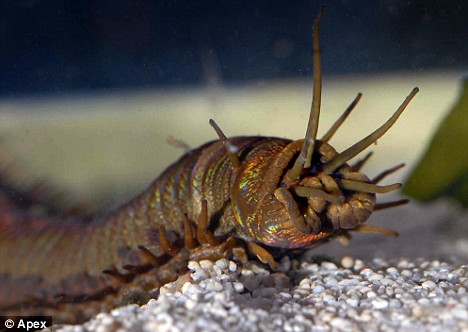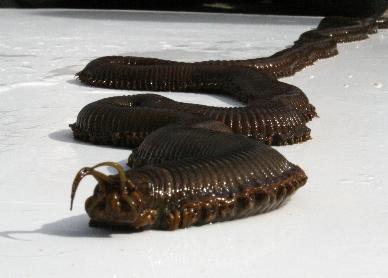Giant Sea Worm Discovery
Posted by: Loren Coleman on April 6th, 2009

This 4-foot-long sea worm was devastating coral reef and terrorizing fish at an aquarium in Cornwall, southwestern England. The creature, known as “Barry,” devoured bait traps — hooks and all — and bit through a 20-pound fishing line before staffers finally managed to capture it. The worm was moved to its own tank.
So, you stock your aquarium full of little fish from the coral reef and apparently other tiny critters come along for the ride. You watch your colony stabilize and then discover a small baby something might have grown up in the batch?
That appears to be the explanation being kicked around about the giant four-foot-long sea worm found in a respectable aquarium collection.

The news has been made the rounds at the end of last week, but I’m into week two of being a bit under the weather and out-of-energy, so here’s some catch-up:
Staff at a British aquarium have captured a massive sea worm that had been terrorizing other aquatic life.
For months, the 4-foot-long creature — which staffers call “Barry” — had been devastating coral reef at Newquay’s Blue Reef Aquarium, the Daily Mail newspaper reported. The menacing monster also apparently injured a Tang fish.
Initially, aquarium workers weren’t sure what was harming the coral, which in some cases was cut in half. After weeks with no clues, they decided to take the display apart to see if they could find the culprit, the Mail reported.
Workers laid bait traps, which were mysteriously destroyed in the night, as the glutton apparently devoured the fish hooks right along with the bait. Finally, staffers spotted the tropical worm, which bit through a 20-pound fishing line before staffers were able to successfully remove it from the tank.
Further background to the story, here.

This is not a new species, but merely an out-of-place animal, so to speak. It is apparently the Giant Reef Bristle Worm, perhaps Eunice aphroditois.
BTW, Eunice aphroditois is also called the “Bobbit Worm” due to the fact that the female worm attacks the male penis and feeds it to her young after mating.

Be a friend, and support the International Cryptozoology Museum and future research in whatever way you can…please today…
About Loren Coleman
Loren Coleman is one of the world’s leading cryptozoologists, some say “the” leading living cryptozoologist. Certainly, he is acknowledged as the current living American researcher and writer who has most popularized cryptozoology in the late 20th and early 21st centuries.
Starting his fieldwork and investigations in 1960, after traveling and trekking extensively in pursuit of cryptozoological mysteries, Coleman began writing to share his experiences in 1969. An honorary member of Ivan T. Sanderson’s Society for the Investigation of the Unexplained in the 1970s, Coleman has been bestowed with similar honorary memberships of the North Idaho College Cryptozoology Club in 1983, and in subsequent years, that of the British Columbia Scientific Cryptozoology Club, CryptoSafari International, and other international organizations. He was also a Life Member and Benefactor of the International Society of Cryptozoology (now-defunct).
Loren Coleman’s daily blog, as a member of the Cryptomundo Team, served as an ongoing avenue of communication for the ever-growing body of cryptozoo news from 2005 through 2013. He returned as an infrequent contributor beginning Halloween week of 2015.
Coleman is the founder in 2003, and current director of the International Cryptozoology Museum in Portland, Maine.










LOL, you have to be over 30 to understand that ‘Bobbit’ reference 🙂
To paraphrase W C Fields; I will never swim in the ocean again because those things are having sex in it.
I’m sticking to freshwater aquariums – PERIOD.
That is why I dislike swimming in the ocean, especially when its murky.
“hey, look at that little fishy….whaaat whaaat is that crawling on my leg!?!?”
Absolutely fascinating! I wish one of the pictures was with a human for scale. It’s good they kept it alive in it’s own tank-an unexpected bonus for any aquarium. That’s alotta worm!
Otters in a row, clearly.
According to the wikipedia entry, these creatures’ lifepatterns are not well known, living as they do buried a few feet down in the mud, but they have been found growing to over twice the length of the one discovered in the aquarium. Creatures that live in the cold mud can have very long lives, keyed into cycles in the environment that might be longer than human’s modern history and who knows if some of these or some related species exhibit indeterminate growth throughout their long lives. Could be yet another candidate for some of the sightings attributed to sea monsters.
I was going to say, what if this is just a neonate?
I bet you this, within one year we will have a new Sci Fi Channel original movie-“SEA WORM-Terror From the Deep!”
I remember a Marine Biology lecturer at Uni showing us some pictures of the abyssal sea bed. These pictures, amongst other things showed various burrows, tracks and casts, nothing particular cryptid or interesting until he revealed the massive scale in these pictures, literally 10’s of meters across. I can’t find these pictures anywhere now, god knows I have looked, but the sizes were stunning. I also remember that there were similarly large symmetrical spiral patterns speculatively accredited to giant marine worm casts.
The same lecture covered the Massive numbers (Known and projected) of nematode worm species on the sea bed some suggest between 100 and 100,000,000!
I guess my point is even the experts know admittedly next to nothing about the deep sea and marine sedimentary environment. Could be anything out there!
Reminds me of the Giant Sand Worms from DUNE. Yikes. 🙂
Believe it or not we actually use a similar (if not the same one) worm as bait in Greece. I have fished many a time with it. And yes the sizes are correct. Largest one I have seen was 3.4 meters long. We call them “Pharaoh” worms because if you keep them for a long time they tend to “hibernate” and build a tough cocoon around them that looks a lot like the mummies found in tombs.
And no you do not use the whole worm as bait, you chop it up. Damn fine bait too.
They are caught by putting a small mound of fish meat outside the hole they live in. Once it pops out to eat it is speared just behind the head which is the hardest part with a small spear attached to a little float. The float eventually pulls the worm out of the hole, something that might take a day or so in some cases.
Gigantism of marine life occurs around thermal vents in the ocean bottom. We are just beginning to explore those regions. I maintain that if when large unknown cryptids are found, it will most likely be these regions of the ocean depths.
Let’s go worm fishing so we can go regular fishing! :-0 These suckers must have some mandibles or hard jaws.
we used this worm as a bait in our province in the philippines, this is scavengers which means it eats everything from coral to dead animals and plants,…